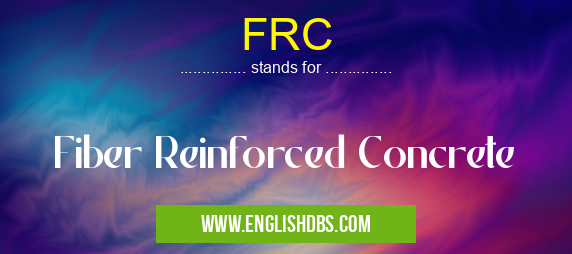What does FRC mean in UNCLASSIFIED
FRC (Fiber Reinforced Concrete) is a versatile construction material that enhances the properties of traditional concrete by embedding reinforcing fibers. These fibers can be made from various materials, including steel, glass, or synthetic polymers, and provide additional strength, ductility, and toughness to the concrete matrix. FRC offers numerous advantages over plain concrete, making it suitable for a wide range of structural and non-structural applications.

FRC meaning in Unclassified in Miscellaneous
FRC mostly used in an acronym Unclassified in Category Miscellaneous that means Fiber Reinforced Concrete
Shorthand: FRC,
Full Form: Fiber Reinforced Concrete
For more information of "Fiber Reinforced Concrete", see the section below.
Definition of FRC
FRC refers to Fiber Reinforced Concrete, a composite material that incorporates reinforcing fibers into a concrete mix. The fibers are typically small, discrete, and randomly dispersed throughout the concrete, acting as internal reinforcement to improve its mechanical performance.
Benefits of FRC
- Increased Strength and Toughness: The fibers in FRC act as a bridge between cracks, preventing their propagation and enhancing the overall strength and toughness of the concrete.
- Improved Ductility: FRC exhibits greater ductility compared to plain concrete, allowing it to deform more before failure and providing improved resistance to cracking and fracture.
- Enhanced Durability: The fibers can help control cracking, reduce permeability, and improve resistance to external factors such as freeze-thaw cycles and chemical attacks.
- Reduced Shrinkage and Creep: FRC has reduced shrinkage and creep properties, minimizing the potential for cracking and deformation over time.
- Versatile Applications: FRC can be used in a wide range of applications, including structural elements, pavements, overlays, and architectural features, providing both functional and aesthetic benefits.
Types of FRC
- Steel Fiber Reinforced Concrete (SFRC): Utilizes steel fibers to enhance tensile strength and toughness.
- Glass Fiber Reinforced Concrete (GFRC): Incorporates glass fibers, providing high tensile strength and crack resistance.
- Synthetic Fiber Reinforced Concrete (SFRC): Employs synthetic fibers made from polymers or carbon, offering improved durability and fiber-matrix bonding.
Essential Questions and Answers on Fiber Reinforced Concrete in "MISCELLANEOUS»UNFILED"
What is Fiber Reinforced Concrete (FRC)?
FRC is a type of concrete that incorporates fibers to enhance its mechanical properties, such as flexural strength, toughness, and impact resistance. These fibers can be made of various materials, including steel, glass, carbon, or synthetic polymers.
What are the advantages of using FRC?
FRC offers several advantages over plain concrete, including:
- Improved flexural strength and toughness: The fibers reinforce the concrete matrix, reducing cracking and increasing its ability to resist bending forces.
- Enhanced impact resistance: The fibers absorb and dissipate impact energy, making FRC more resistant to damage from impact loads.
- Reduced shrinkage cracking: The fibers help to control shrinkage stresses, minimizing the formation of cracks during the curing process.
- Improved durability: FRC has better resistance to freeze-thaw cycles, abrasion, and chemical attack due to the presence of fibers.
Where can FRC be used?
FRC has a wide range of applications in construction, including:
- Pavements and slabs: FRC is used in pavements, sidewalks, and bridge decks to improve their durability and resistance to cracking.
- Structural elements: FRC is used in beams, columns, and slabs to enhance their flexural strength and reduce the risk of brittle failures.
- Shotcrete and precast applications: FRC is well-suited for shotcrete applications due to its increased toughness and ability to bridge cracks. It is also used in precast elements to improve their handling and impact resistance.
- Industrial and marine structures: FRC is used in industrial floors, offshore platforms, and marine structures due to its enhanced durability and resistance to aggressive environments.
What types of fibers are used in FRC?
The most common types of fibers used in FRC are:
- Steel fibers: Steel fibers are highly effective in increasing the flexural strength and toughness of concrete.
- Glass fibers: Glass fibers are less expensive than steel fibers and improve the tensile strength and crack resistance of concrete.
- Carbon fibers: Carbon fibers are more expensive but offer excellent strength and stiffness properties.
- Synthetic fibers: Synthetic fibers are lightweight and can improve the workability and durability of concrete.
Final Words: FRC (Fiber Reinforced Concrete) is an innovative construction material that offers significant advantages over plain concrete. Its enhanced strength, toughness, ductility, durability, and reduced shrinkage make it a versatile choice for various structural and non-structural applications. By incorporating reinforcing fibers into the concrete matrix, FRC provides improved performance and increased durability, making it an essential material for modern construction practices.
FRC also stands for: |
|
| All stands for FRC |
